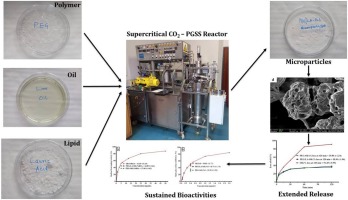Journal of CO2 Utilization ( IF 7.2 ) Pub Date : 2020-03-05 , DOI: 10.1016/j.jcou.2020.02.014 Jubril Olayinka Akolade , Khadeejah Olubukola Nasir-Naeem , Andri Swanepoel , Abdullahi Ahmed Yusuf , Mohammed Balogun , Philip Labuschagne

|
Applications of essential oils as chemotherapeutics are limited because these aromatic oils are generally volatile, insoluble in aqueous media and easily degraded to non-active constituents when subjected to thermal-oxidative processes. The particles from gas-saturated solution (PGSS) technology allows for non-destructive processing of volatile oils into micronized formulations under high pressure and moderate temperature using supercritical carbon dioxide (scCO2). In this study, essential oil from lime (Citrus aurantifolia) with proven antidiabetic activity was processed with polyethylene glycol (PEG) and lauric acid (LA) using scCO2 in a high pressure reactor for 2 h at 120 bar and 45 °C. The polymer-oil mixtures were co-precipitated and micronized through a 500 μm nozzle. PGSS processing of C. aurantifolia oil with PEG and LA yielded roughly spherical microparticles with sizes ∼ 2 μm. Inclusion of the LA and encapsulation of the limonene-rich oil into the PEG particles were confirmed using FTIR and GC/MS respectively. Melting point and heat of fusion of the PEG/LA microparticles were lower when compared with particles produced with PEG only, resulting in higher oil loading capacity and yield. The scCO2-assisted polymeric encapsulation of the volatile oil reduced rapid vaporization and incorporation of LA with the PEG-oil formulation extended the mean release time in simulated physiological solutions. Free radical scavenging and alpha-amylase inhibitory activities of the lime oil were also preserved following encapsulation in the PEG/LA microparticles. In summary, production of PEG/LA microparticles with high yield and loading capacity of bioactive lime essential oil was achieved using the scCO2 encapsulation technology.
中文翻译:

CO 2辅助生产的聚乙二醇/月桂酸微粒,用于延长柑桔精油的释放
香精油作为化学治疗剂的应用受到限制,因为这些芳族油通常易挥发,不溶于水介质,并且在进行热氧化过程时容易降解为非活性成分。来自气体饱和溶液(PGSS)技术的颗粒允许使用超临界二氧化碳(scCO 2)在高压和中等温度下将挥发油无损加工成微粉化配方。在这项研究中,使用scCO 2将聚乙二醇(PEG)和月桂酸(LA)加工出具有抗糖尿病活性的石灰(Citrus aurantifolia)精油。在高压反应器中于120 bar和45°C下放置2 h。将聚合物-油混合物共沉淀并通过500μm喷嘴微粉化。的PGSS处理C. aurantifolia用PEG和LA油,得到大致球形的微粒与尺寸〜2微米。分别使用FTIR和GC / MS确认了LA的包入和富柠檬烯油的包封在PEG颗粒中。当与仅用PEG生产的颗粒相比时,PEG / LA微粒的熔点和熔化热较低,从而导致更高的载油量和产率。scCO 2挥发油的辅助聚合物包封减少了快速蒸发,并且将LA与PEG油配方结合使用可延长模拟生理溶液中的平均释放时间。封装在PEG / LA微粒中后,还保留了石灰油的自由基清除和α-淀粉酶抑制活性。总之,使用scCO 2包封技术实现了具有高收率和生物活性石灰精油负载量的PEG / LA微粒的生产。











































 京公网安备 11010802027423号
京公网安备 11010802027423号